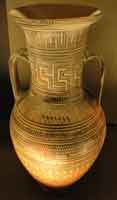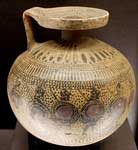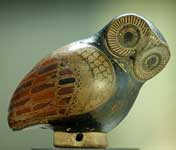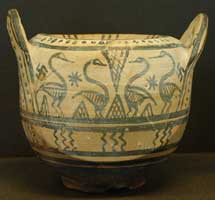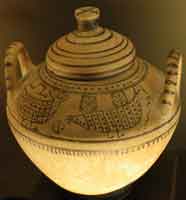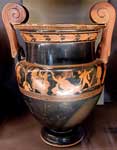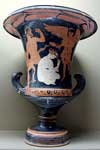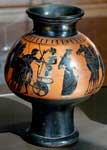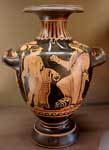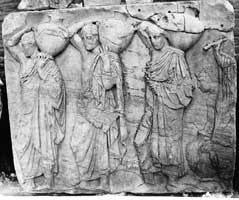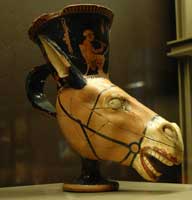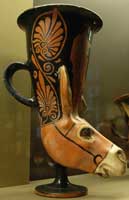Part 1
Griechische Vasen
1) Minoan pottery
2) Ancient Greek Pottery
I am the cup of Nestor, a joy to drink from. Whoever drinks this cup straightway that man the desire of beautiful-crowned Aphrodite will seize Inscription of the “'cup of Nestor” from Pithekoussai, Powell. Homer and the Origin, 68-118; E. Havelock, The Literate Revolution in Greece and Its Cultural Consequences (Princeton: Princeton University Press, 1982)
Pottery was produced in many places in Greece. Athens and Corinth produced the finest pottery. One special place was the Kerameikos (Κεραμεικός)(ceramic) west of the Athenian agora and close to the Eridanus river (Kerameikos according to Pausanias was derived from Keramos, a son of Dionysus and Anadne).
Shapes and Use - Σχήματα και Χρήση
Storage
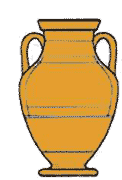
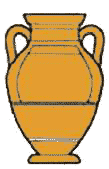
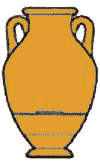
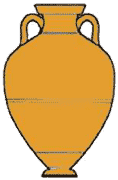
Amphorae: A, B, C, Panathenaic (Παναθηναϊκοί αμφορείς)
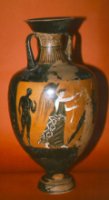
Example of a Panathenaic Amphora given as a prize in the Panathenaic Games.

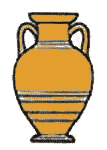

Neck Amphorae: Standard, Ovid, Nolan
The Amphora (Αμφορεύς): A tall, two-handled (amphoreus, carrying from both sides) storage vessel for wine, corn, oil, or honey storage. Amphorae were produced in large numbers. More than 1000 amphorae could be on board of a merchant ship and there are cases known where this number was up to 10 times larger. They were of course without decoration and a so called “pointed bottom amphora” version was used which allowed them to be fixed by special openings in a ship's hold.
Amphora Types According to Dressel
The Amphora Project has many information and references about the amphorae
|
|

Dipylon amphora
|
|
Dipylon Vase: A giant amphora (or Krater) (around 5 feet) used to mark the tomb of an aristocrat, decorated almost completely with geometric figures and a central scene of a deceased surrounded by his family and friends (so called prothesis scence)
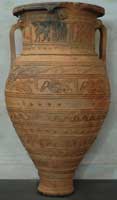
Pithos from Crete
Other storage types: Pithos ( Πίθος )
Drinking Cup



Cups: Kylix A,B,C
Kylix (pl. Kylikes) (Κύλιξ): Drinking cup. Type A has a division between the body and foot.
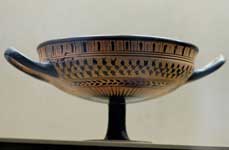
Kassel cup, Louvre E673
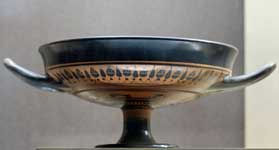
Droop cup, Louvre CA2512

"Eye" Kylix
Cups:


Black Figure: Komast, Siana (Rhodes)
Siana Cups are decorated on the inside.


Lip, Band
(also versions Cassel-Cup, Droop-Cup, Gordion-Cup, Little Master Cup)
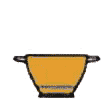
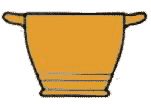

Skyphos (pl. Skyphoi) (Σκύφος): Corinthian, Athenian, Cup Skyphos
Corinthian Skyphos: A deep bowl with a horizontal handle on either side below the lip and small stand.
Cup Skyphos: A hybrid version of the skyphos and the kylix with a shallow bowl with a handle extended upward on either side and a heavy stand.

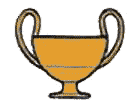

Kantharos (pl. Kantharoi) (Κάνθαρος): A, B, C
Kantharos (i.e. dung beetle, maybe used for this shape). A deep bowl with a high vertical handle on either side and a tall stand.
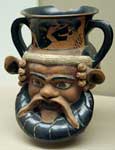
Janiform kantharos BM E786
Oil Flask




Lekythoi (pl. Lekythoi )(Λήκυθος) (small version: Lekythion): Dianeira, Shoulder, Cylinder, Squat

Acorn-Lekythos, Louvre MNB1320
The Lekythos: An oil flask with a long, narrow neck, for funeral offerings. It was used to anoint the body after death. Dianeira version with long oval body. Squat version with a heavy body.
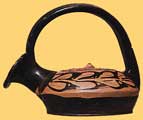
Askos (Image from M. Andronikos)
Other: Askos (Ασκός), Kothon (Κώθων), Plemochoe (Πλημοχόη)(cosmetic jar for women), Amphoriskos, Lydion (Λύδιον) (a rare black figure shapre original from Lydia)
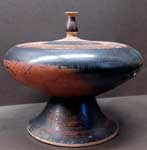
Black-glaze plemochoe, Louvre CA3131
For Ointment



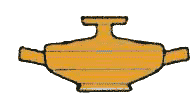
Aryballos (Αρύβαλλος), Alabastron (Αλάβαστρον), Pyxis (Πυξίς), Lekanis (Λεκάνη)
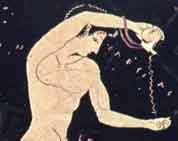
Laconian Aryballoi were widely exported, filled with olive oil used by athletes to cover their body.
The Pyxis is a box-shaped pottery with a lid and used for ointments and cosmetics. The Lekanis was a specialized vessel often given as a wedding gift. This form appears from the early 6th century BC. Unglazed lekanides were among the most important products of 5th century potters in Corinth.
Mixing Bowl
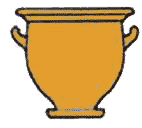
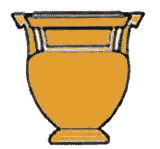
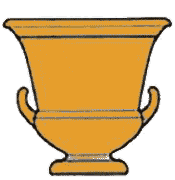
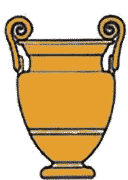
Krater (Κρατήρ): Bell, Column, Calyx, Volute
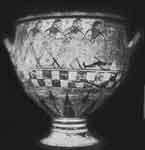
Blinding of Polyphemus, Aristonothos Krater c. 680/70 BC
The Krater (or Crater): A large bowl for mixing wine and water. Calyx kraters have an organic shape, Volute kraters have spiral handles.

Dinos, Louvre Cp11243
Dinos [deinos] vessel, used as a mixing bowl . The Exekias Painter and Potter is considered as the inventor of the Calyx Krater shape. Euphronios Krater
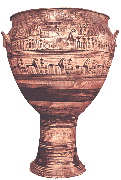
Dipylon Krater
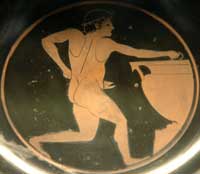
Youth using an oinochoe (wine jug, in his right hand) to draw wine from a crater, in order to fill a kylix (cup with a Kalos inscription, "praising" the beauty "kalos" of a person)
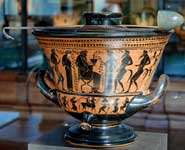
Crater Psykter, Louvre MNE938
The Francois Vase a major monument in Greek Pottery history, smashed by a Museum guard in 1900 in 638 pieces. The restored volute krater with many illustrations of various mythological stories.
High Resolution Images of the Derveni Bronze Crater , (More Images), a masterpiece
Ritual Vase


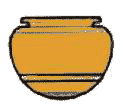
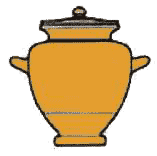

Loutrophoros (Λουτροφόρος) , Pelike (Πελίκη), Lebes (Λέβης), Stamnos (Στάμνος), Lebes Gamikos (Λέβης γαμικός)

Lebes Gamikos, Louvre K196

Pelike women BM F310
The Loutrophoros (loutron phero) means bring a bath is a tall vase with a high, funnel-shaped neck, a slender body and a flaring mouth. It was used for carrying water for a bride's ceremonial bath. It was placed in the grave of an individual who died before marriage.
The Lebes gamikos means deep bowl (lebes) and marriage (gamikos).
Other: Phiale (Φιάλη), Phormiskos(Φορμίσκος), Nestoris (Νεστορίς), Patela, Kernos (Κέρνος)

Nestoris, Louvre K534
Cooler and Water Jug


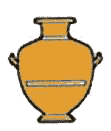
Psykter (Ψυκτήρ), Hydriae: Black, Red Type
Psykter (Cooler for wine).
The Hydria: A three-handled water jug used for carrying water from fountains and wells to the home. Hydriae in the Hellenistic times were used, for example in Alexandria, also as a Funerary Urn (Hydriotaphia). According to Homer the bones of the dead Achilles were put in a golden Amphora together with that of Patroclos and Hector's bones in a Larnax, a box.
Hydria Images
Jug





Oinochoai: 1, 2, 3, 7, 10
The oinochoe (or oenochoe) (Οινοχόη ): a wine jug with a pinched lip. Oinochoe from Oinos and Cheo (wine and flow). Oinochoos also is some who pours wine. At a Greek symposium the oinochoai were usually young slaves. Their duty was to mix the wine, bring in the mixers and with long handled ladles or with wine-jugs dip the wine from the mixers (kraters) and fill the drinking cups for the guests, who received them as they reclined upon the couches.
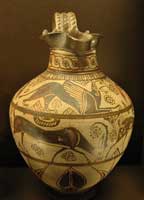
Oinochoe from Rhodes
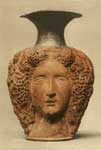
Oinochoe from Eretria

Epichysis, Louvre ED859
Other types: Chous (Χους), Epichysis (Επίχυσις), Lagynos (Λάγυνος), Olpe
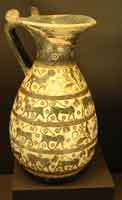
Olpe from Corinth
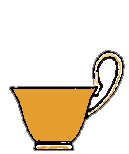
Kyathos (Κύαθος)
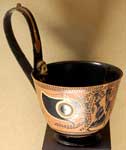
Kyathos, Louvre CA3309
Cooking Pot
Klibanos, Lopas, Teganon, Chytra, Kakkabe, Eschara (http://www.geocities.com/Paris/Louvre/6039/brazier.html )
Plates
Pinax or Pinakion (Πινάκιον), fish plate (decorated with fish images or squids and other sea creatures, examples from Paestum)
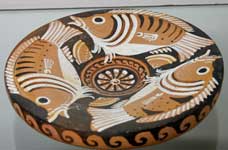
Fish-plate Karlsruhe BM F266
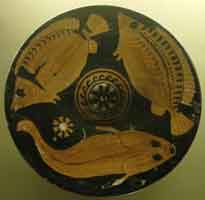
Fishplate
Sundry
Kados (Κάδος)(bucket), Lekane, Situla, Amis, Feeder,
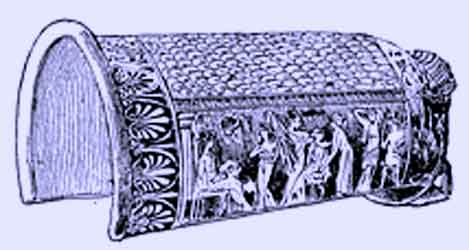

Epinetron (Επίνητρον) - a pottery thigh protector that women wore over her leg when roving wool. Images:
Onos, Kalathos,(Κάλαθος) Lamp, Louterion, Perirrhanterion
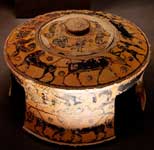
Tripod Exaleiptron, Louvre CA927
See: Industrial production of lamps
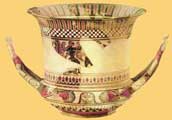
Laconian Lakaina
Strange/Funny
Rhyton (Ρυτόν)
Rhyton: Drinking horn in the shape of a head of the animal, such as a bull, a sheep, a donkey, a deer, a goat and a boar, and curved like a horn with a vertical handle. Among the Greeks the drinking horn received elaborate development, and was technically designated by the term rhyton, (from rheo flow), since it had a small opening at the bottom which the drinker put into his mouth and thus allowed the wine to run in. The rhyton as an artistic development of the earlier horn, was made of pottery or metal and was modelled into the head of an animal, so that the special cup might be called ippos (horse), elafos (deer), kapros (boar), etc. More Information
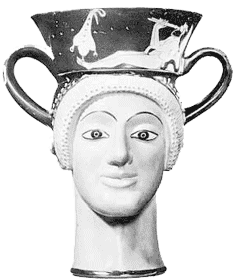
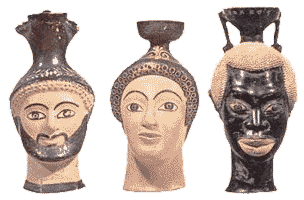
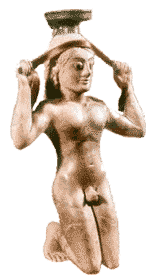
Figured Vase In form of a human head, or an entire body (athlete binding a ribbon, a symbol of victory, around his head)
Other types: Astragalos, bobbin (like a yo-yo shape)
Miscellaneous
Cotyle or Kotyle (Κοτύλη) similar to the Skyphos (or a unit of 0.27 liter), Oon (Ωόν) with the shape of an egg on a base
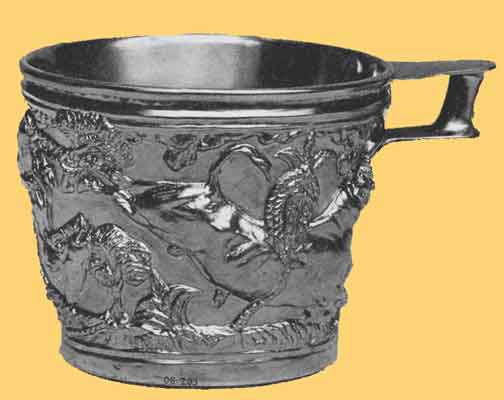
Mycenaean Vaphio Cup, c. 1500 BC
With the Greeks every handicraft was an art: with the Romans every art was a handicraft. Marquardt
Part 2
Index Greek Life
Early Greek Vase Painting: 11Th-6Th Centuries Bc: A Handbook (World of Art) , John Boardman, Thames & Hudson (May 1998)
Athenian Black Figure Vases: A Handbook (World of Art) , John Boardman, Thames & Hudson; Reprint edition (February 1985)
Athenian Red Figure Vases: The Classical Period : A Handbook (World of Art), John Boardman, Thames & Hudson (December 1989)
| Ancient Greece
Science, Technology , Medicine , Warfare, , Biographies , Life , Cities/Places/Maps , Arts , Literature , Philosophy ,Olympics, Mythology , History , Images
Medieval Greece / Byzantine Empire
Science, Technology, Arts, , Warfare , Literature, Biographies, Icons, History
Modern Greece
Cities, Islands, Regions, Fauna/Flora ,Biographies , History , Warfare, Science/Technology, Literature, Music , Arts , Film/Actors , Sport , Fashion
---
Cyprus
Greek-Library - Scientific Library
|







































